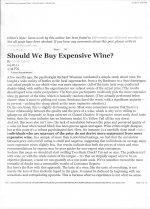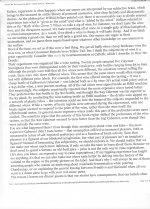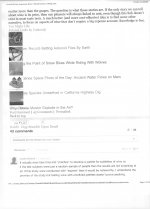I will always remember helping a friend pick out a Martin D28 guitar out of many dozens of choices. ...how would you quantify the differences between what are supposed to be identical instruments? There was just a tonality to the one we chose that has nothing to do with distortion or any other measure I can think of.
Are the D28s really supposed to be identical instruments? They are hand-made, and made from wood which can, and does, vary in it's properties (from sample to sample and over time). Of course different D28s sound different, and even have different physical properties (eg., different fingering).
How would I quantify the difference? I would measure the sound of various plucked strings, look at the spectra, and look at how the spectra change over time (attack, sustain, decay). Would that tell me what the guitar sounds like? No. But I bet if you did the measurements on lots of guitars, and listened to those guitars, you could learn to identify some sonic qualities with the spectra. I also bet that there are people in guitar factories (not your local luthier, but bigger factories) who do exactly that.
Having said all of that, my stereo is not an instrument, it is a reproducer. All I ask of it is that it come close to reproducing the signal that I put into it. Whether that sounds like your friend's guitar has a lot to do with how it was miked, in what location, how it was mixed and recorded. One thing I'm pretty sure of is it won't sound like someone is playing that guitar in my living room, but I hope it will sound pretty similar, and capture some of the ambience of the place where it was recorded.
nezbleu,
While I understand what you are saying about measuring the spectra of an instrument that is still going to come down to a subjective opinion of what or how we relate any sound to some defined objective standard. I don't think that will ever happen. The problem again in reproduction is since there is no perfect loudspeaker and there never will be the chain that we are listening to will always have a subjective component to the end result. There is no way at his time to take that component out of the equation. The questions is can you have a reproduction chain that at least at time fools you into believing a real instrument or person is in the room? If so you are probably as close to the holy grail as you will ever attain.
While I understand what you are saying about measuring the spectra of an instrument that is still going to come down to a subjective opinion of what or how we relate any sound to some defined objective standard. I don't think that will ever happen. The problem again in reproduction is since there is no perfect loudspeaker and there never will be the chain that we are listening to will always have a subjective component to the end result. There is no way at his time to take that component out of the equation. The questions is can you have a reproduction chain that at least at time fools you into believing a real instrument or person is in the room? If so you are probably as close to the holy grail as you will ever attain.
Kindhornman, now you are talking my language! (whether you meant to or not) '-)
Ever since I was a teenager, I was very sensitive to sound differences in guitars. I bought my first really high quality classical guitar in 1960, when I was 18 years old. It was stolen 3 years later, but it went with me almost everywhere, until then. In 1963, working in LA, I tried to find a replacement, to no avail, so 6 mo later I went to Mexico to find the best guitar that I could find and I found a pretty good one, but I was never satisfied with it, so I sold it. Actually I traded it for a Triplett Voltmeter.
Finally, years later, I traded some audio equipment for a really nice Martin. It was unfortunately destroyed in a firestorm in 1991. I guess I just can't keep quality guitars around.
The point is:
Some of us are more sensitive to small sound differences than many others. That is why we pick guitars, or even select and modify audio equipment.
I don't need a double blind test for this, OR differences in wine quality. In fact, it can get in the way of enjoying subtle differences.
Ever since I was a teenager, I was very sensitive to sound differences in guitars. I bought my first really high quality classical guitar in 1960, when I was 18 years old. It was stolen 3 years later, but it went with me almost everywhere, until then. In 1963, working in LA, I tried to find a replacement, to no avail, so 6 mo later I went to Mexico to find the best guitar that I could find and I found a pretty good one, but I was never satisfied with it, so I sold it. Actually I traded it for a Triplett Voltmeter.
Finally, years later, I traded some audio equipment for a really nice Martin. It was unfortunately destroyed in a firestorm in 1991. I guess I just can't keep quality guitars around.
The point is:
Some of us are more sensitive to small sound differences than many others. That is why we pick guitars, or even select and modify audio equipment.
I don't need a double blind test for this, OR differences in wine quality. In fact, it can get in the way of enjoying subtle differences.
How do we know we are not fooling ourselves? Where is the measurement of the wine that shows the differences in taste? Before talking about any one wine being better than another, should we not subject it to a double blind test from a noted university?
I just say this to point out the similar problem with the debates about audio quality.
I let my brain decide what are the best audio quality and the best wine quality.
So when listening to music or drinking wine I simply enjoy the very best there is 😀
SY should write a book, discrediting audio quality. It would be easier to note his arguments if it were in print in a specific book, or dialogue.
SY should write a book, discrediting audio quality. It would be easier to note his arguments if it were in print in a specific book, or dialogue.
I'm quite interested in audio quality and have spend much of the past 45 years or so pursuing it, so I take more effort than perhaps I should to discredit misunderstanding, fraud, and self-promoting b*******.
I would prefer him to write a book on achieving audio quality. Of course, he might need to give some space to debunking spurious claims to alleged audio quality, and fanciful arguments lending 'support' to daft claims.john curl said:SY should write a book, discrediting audio quality.
In audio, the notoriously short-term memory of most for certain discernibly audible things is often cited as justification for rapid sequencing among objects under evaluation. But although I can't cite studies to support, I suspect that there are other long-term perceptual shifts that also exert an influence. So at the end of the day or days, what we perceive as a change in the equipment may be difficult to separate from a change or adaptation in ourselves, or even other seemingly unrelated effects.
This is an astute observation that deserves more attention.
Anybody who has worked to develop a piece of audio might recognize this effect. In a listening test, you could pick up something you feel is slightly wrong, and then the next day it is gone, without changing anything in the setup. The other way around is possible too. If, in the meanwhile, you had changed the interconnects from copper to silver, you could easily attribute it to that. Whereas it is just that one day is not the other.
Only comprehesive measurements and DBT can shield you from this.
Last edited:
I would prefer him to write a book on achieving audio quality.
After seeing what it took Morgan Jones to put together a book of the sort of quality I'd be proud of and seeing what he netted for something which sold extremely well for its niche, I can assure you that I won't be writing any books. 😀
... The problem again in reproduction is since there is no perfect loudspeaker and there never will be the chain that we are listening to will always have a subjective component to the end result. There is no way at his time to take that component out of the equation. The questions is can you have a reproduction chain that at least at time fools you into believing a real instrument or person is in the room? If so you are probably as close to the holy grail as you will ever attain.
My reproduction setup never make me think real instrument(s) or person(s) are in the room. AFAIK, that is impossible. Yet, my reproduction setup gives me a *sense* close to the sense of listening to live music.
As I mentioned, probably in here, Toole gets a check from time to time for Sound Reproduction that pays for a restaurant meal or two. And that book has also been doing well, given its field.After seeing what it took Morgan Jones to put together a book of the sort of quality I'd be proud of and seeing what he netted for something which sold extremely well for its niche, I can assure you that I won't be writing any books. 😀
Other than best-selling thrillers etc., the other books that can make money for the authors are undergraduate textbooks, if they get adopted in enough places. George Abell was making about 100k a year for The Exploration of the Universe, and that was when that was a substantial sum.
That's the goal. I differ with the views of several here who believe that a fully convincing illusion can't be achieved, simply because I've managed to do that over and over again, in many different environments, with very varied equipment, in type and quality. To take it back again to a wine analogy, I had a Australian red nearly 30 years that was "as good as it gets" - at the time, and in my memories and following experiences I could not envisage a wine being "better" - many years later I had a Grange in excellent drinking shape, and this was, yes, you could appreciate the quality of the fruit and the skill of the winemaker - but it didn't bowl me over, you could easily conceive a superior version.My reproduction setup never make me think real instrument(s) or person(s) are in the room. AFAIK, that is impossible. Yet, my reproduction setup gives me a *sense* close to the sense of listening to live music.
So, in audio terms I 'know' how good it gets, the memory and impact of such is locked into my brain in the same way the impact of that red 30 years ago still is. The fact that at the moment achieving that endpoint in SQ is always a major exercise, is a technical, an implementation 'barrier', and is only that.
The measurements can be done by ear, the trick is to use segments of recordings which highlight, emphasise whether it's thumbs up, or down. 'Stressful' passages can be repeated ad nauseum, and make it as clear as a reading on a meter. For example, there is a short drumming snippet on Paul Simon's 'Gracelands' which 95% of systems make a complete mess of - this is a good test for getting the 'Seal of Approval' ...Anybody who has worked to develop a piece of audio might recognize this effect. In a listening test, you could pick up something you feel is slightly wrong, and then the next day it is gone, without changing anything in the setup. The other way around is possible too. If, in the meanwhile, you had changed the interconnects from copper to silver, you could easily attribute it to that. Whereas it is just that one day is not the other.
Only comprehesive measurements and DBT can shield you from this.
Many here are happy discussing subjective differences in wine... Where is the measurement of the wine that shows the differences in taste? Before talking about any one wine being better than another, should we not subject it to a double blind test...?
...I don't need a double blind test for this, OR differences in wine quality. In fact, it can get in the way of enjoying subtle differences.
I own textbooks about exactly that: the chemistry of wine and the corresponding taste sensations. Every good winery employs winemakers and blenders who understand the chemistry, and who can measure pH, Brix, alcohol content, residual sugar, tartrate content, different acids, etc. When people are actually trained to taste wine (as opposed to just swilling whatever they can afford, which is my technique) they spend time smelling and tasting particular compounds in varying concentrations, and comparing those with wines. So, like good audio designers, they taste (listen) and measure, both, because one without the other cannot produce a good product. It's one thing to taste a wine and say "I don't like it" or, as one English wine reviewer famously wrote, "...has an aroma like entrails of roast woodcock", but it's another to taste a wine and say "malolactic fermentation has changed the acid balance and contributed a diacetyl flavour". More importantly, a trained wine maker/taster knows how to fix a wine with certain problems, just as a good audio designer knows how to fix certain problems with a circuit, but in both cases a proper analysis is required. Applying "fixes" without measurement is just flailing in the dark.
As for double-blind testing/tasting, no serious wine tasters or reviewers perform sighted tastings except for "training" purposes. Even when evaluating a particular wine, they do blind comparisons with known products. You should choose your analogies more carefully.
On another subject: I got my copy of Summer 2013 'Solid-State Circuits Magazine' that features Paul Brokaw, in several articles. Fascinating story.
- Status
- Not open for further replies.
- Home
- Member Areas
- The Lounge
- John Curl's Blowtorch preamplifier part II


